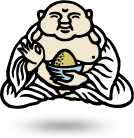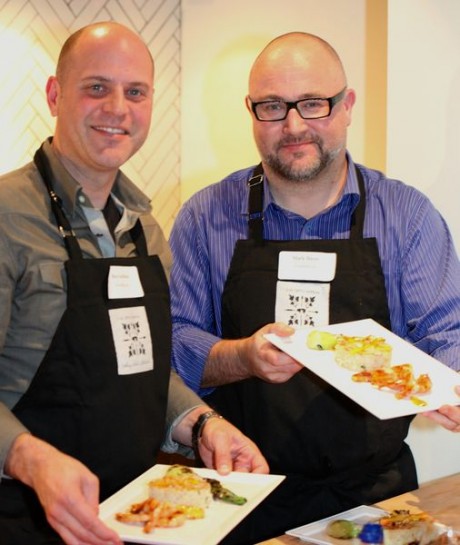Blue Dragon Heat
Posted by Ben Garfinkel on Monday, December 17th, 2012Tags for this Article: asian cooking, Blue Dragon, brandade, charity, cod, recipe
The ‘heat’ referenced in the post title is as much about competition as it is about spice
At Foodists, we get a fair amount of attention from PR people pitching all manner of restaurants, products, etc. As a rule, we’re not given to gushing forth and shilling for companies, unless it’s something we would ourselves use or support.
So it was that fellow Foodist Mark Busse and I found ourselves one recent Monday evening ensconced in the lovely Dirty Apron Cooking School with a collection of invited food personalities sipping on wine and nibbling canapés. The impetus for our presence was to launch Blue Dragon Asian Cooking Sauces to Canada by way of a cooking competition for charity. Having just returned from an out of town business trip the week before, Mark and I were a little unprepared and just rolling with things, smiling and hoping to have some fun for a good cause.
The week before, we received a package of Blue Dragon Asian Cooking Sauces by AB World Foods, manufacturer of the well-known line of Patak’s sauces and other Southeast Asian products. The idea being that we’d have some time to familiarize ourselves with the product before competing against six other duos in an Iron Chef-like cooking competition, the winners getting to direct $2,000 to their charity of choice. Lots of companies use charities to gloss over their rather blatant marketing efforts, and maybe there’s nothing wrong with that if you are honest about it. Layer on some mystery, competitive spirit, awesome venue and lubricate with food and wine and, hell, you’ve got something!
That’s how I went from thinking “this could be interesting, but we’ll see” to “man, this is fun” in the course of under an hour.
If you are at all familiar with the Dirty Apron Cooking School, normally you and a partner are situated at one of the well-equipped cooking stations and the instructor chef is at the front of the room behind a long table. This night, Nathan Fong took the helm to emcee the function; the long table laden with a grocery store’s worth of vegetables, proteins and, of course, every available sauce from the Blue Dragon line. That was the catch: your dish had to use one or more of the products. We were to get 10 minutes to sort out what we planned to make and then 45 minutes to plate three of them for the judges: Barbara-Jo McIntosh, Stephanie Yuen and Vikram Verghese (of AB World Foods).
Neither Mark or I are much for pre-packaged sauces, though are always up for a challenge. Personally, aside from not really knowing what we were going to make (and NOT make) I felt prepared enough. The small tingle of nervousness was nicely offset with years of whipping open the fridge and seeing a meal where others only see scraps I guess.
The lack of affection for packaged sauces is a combination of preferring to make them from scratch when cooking, the historically poor quality and flavour of existing products, and the usual culprits of unhealthy and hard-to-pronounce additives. Turns out, Blue Dragon saw an opportunity here. In their words:
Unlike other popular Asian food brands, Blue Dragon uses only the highest quality natural and authentic ingredients with little to no additives. Remarkably, each sauce, seasoning, and paste is made with basics that can be found in your kitchen pantry — you can actually pronounce the ingredients!…
The line is entirely free of MSG and the sodium levels are also much lower than those found in competing brands. Now you can quickly recreate at home, some of the wonderful dishes you have experienced at your favourite Asian restaurant, be it Chinese, Vietnamese, Thai or Japanese.
The line comprises a variety of Asian cooking staples like coconut milk, fish sauce, nuoc cham (vietnamese dipping sauce) and sesame oil, as well as ten definitive Stir-Fry pouches, cooking sauces, and curry pastes that are unique to the brand.
Okay, so to the main event. Unleashed into the arena, the teams spilled over the potential ingredients. Mark and I quickly decided that we did not want to do a traditional stir-fry, and that we wanted to use some of the sauces to build on, not feature. Something about taking the idea of a brandade and doing an Asian version seemed both appropriate and unusual enough to be interesting. Problem was, there wasn’t a potato in sight. The solution: pre-fried rice and cooked rice noodles.
Our other selected ingredients were Shanghai Bok Choy, Pineapple, Cashews, Green Onion, Cod, Prawns, Eggs, Carrots, and Yellow Peppers. We used a good selection of Blue Dragon in the process, including: Chili Coconut Stir-Fry Sauce, Coconut Milk, Sweet Chili Dipping Sauce, and the Nuoc Cham Dipping Sauce.
After a scramble collecting ingredients, we were heads-down in banging out our mis en place and cooking simultaneously. Time really flew by too, and we were literally wiping the last drop off the plate edges when the allotted 55 minutes was up.
Here’s what we accomplished:
Cod Brandades in Chilli-Coconut Cream Sauce
Our Vietnamese-inspired “brandades” (see Note) were a mixture of cooked white rice, cooked/chopped rice noodles, egg, salt and pepper, chopped green onion, sautéed white onion and garlic, fresh ginger, cod poached in coconut milk and Blue Dragon Chilli Coconut Stir-Fry Sauce (save these combined liquids!). These were formed into patties in ring molds and baked at 400 deg. F. for 20 min.
We used prawns shelled and marinated for 30 min. in a mixture of Blue Dragon Vietnamese Nuoc Cham dipping sauce, Sweet Chilli Sauce, and pepper. They were then flash-grilled for 30 sec. per side.
Slicing pineapple into wedges, we marinated it with Blue Dragon Sweet Chilli Sauce and grilled it for 5 min. To accompany our dish, we sliced Shanghai bok choy in half, brushed it with a little oil seasoned with salt and pepper, and grilled it 5 min.
Reducing the reserved coconut-milk poaching liquid (above) with a little white wine, we blended it smooth before spooning it over the brandades. We finished the “brandades” with a flurry of roasted, chopped cashews and a sprinkling of julienned carrot and yellow pepper. A decent combination of spicy, sweet, salty, crunchy and soft.
Note: A traditional “brandade” is an emulsion of salt cod and and olive oil, originally from France. Our version is an interpretation of the traditional.
Since we had to make it up as we went, you can wing the quantities. Just do what feels right.
This was also an exercise in restraint to a degree. It was, in moments, tempting to mix in more sauces and ingredients. In the end, the complexity of the brandade and sauce was nicely balanced against the ungarnished bok choy and the simply grilled pineapple. Clearly the judges thought so too because we were awarded top choice!
A rather unexpected end to what was a surprisingly fun Monday evening, for us and BC Children’s Hospital and Museum of Vancouver, my and Mark’s respective charities.
What I took away from all this was not to be so jaded about all PR/Marketing coming from packaged goods companies, I really like cooking on the fly and while it’s unlikely most home cooks will use that many sauces to prepare one meal, you can! The Nuoc Cham and the Sweet Chili keep in the fridge for a while too.
Admittedly, I’ve yet to crack open a jar of the stir-fry sauce and just toss it into some noodles and veg, but plan to do so soon, just to test the stuff out in its ‘pure’ state. In the meantime, hopefully this inspires you to get a little creative in the kitchen. Even if that means just jazzing up a bottle of packaged sauce of some kind.
Congrats to Rick Green and Nicole Parton, who took second place with their Thai Coconut-Curry Salmon, and all the other competitors that evening. It was a blast.
Look for Blue Dragon at the following retailers: RCSS West, Walmart, Country Grocers and Fairway Markets, and we’re assured, more coming on board soon.




Posted on April 20th, 2013
Eliza Lawall says:
Asian cuisine styles can be broken down into several tiny regional styles that have rooted the peoples and cultures of those regions. The major types can be roughly defined as East Asian with its origins in Imperial China and now encompassing modern Japan and the Korean peninsula; Southeast Asian which encompasses Cambodia, Laos, Thailand, Viet Nam, Brunei, Indonesia, Malaysia, Singapore, and the Philippines; South Asian states that are made up of India, Burma, Sri Lanka, Bangladesh and Pakistan as well as several other countries in this region of the continent.`
The latest piece of writing produced by our internet page
http://www.caramoan.ph/history-of-caramoan/